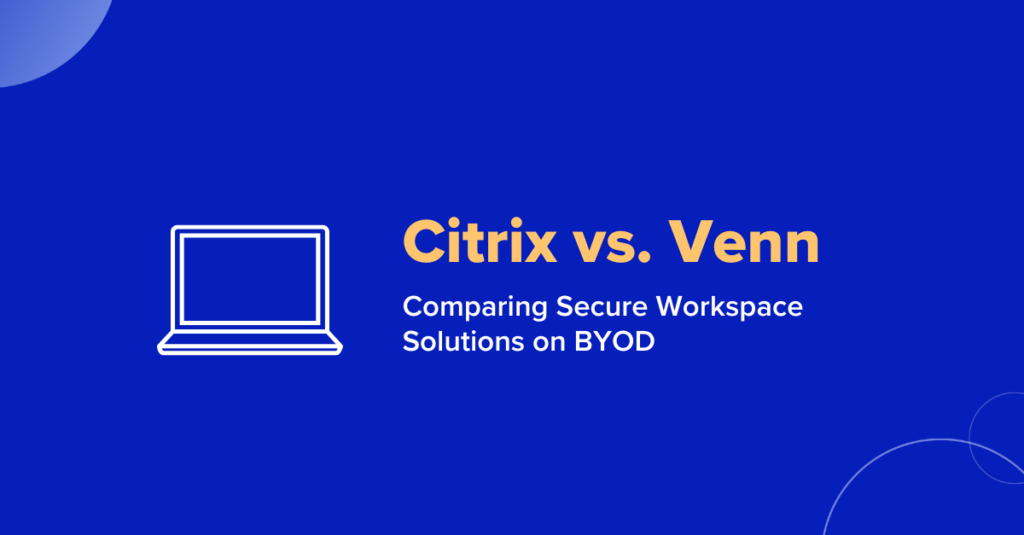Citrix vs Venn: Comparing Remote Work Security Solutions for BYOD

Bring-your-own-device (BYOD) policies have become extremely popular in organizations, especially with the rise of remote and hybrid work. Ideally, the use of personal devices can significantly enhance the user experience and increase productivity. Users can work from anywhere, at any time.
However, this new approach also means that many companies are trusting contractors, partners, employees, and their devices with corporate data and apps. Yet, these devices (PCs, Macs, Mobile Devices) often lack the security controls that managed devices have, making them potentially more exploitable for attackers. As a result, there is increased potential for data loss or network infiltrations, creating new security risks.
At the same time, imposing “heavy” enterprise controls results in frustrated users and productivity loss, which are arguably just as risky for the business. This creates IT challenges, who need to find a way to let users securely connect without friction
This is precisely why, when building a remote work infrastructure, it’s vital to select a remote work security solution that both secures corporate data and works for your users. Citrix and Venn Software take very different approaches to secure remote work on Bring Your Own Device (BYOD Security). While Citrix offers a traditional Virtual Desktop Infrastructure (VDI) and a Desktop as a Service (DaaS) solution, requiring users to connect from their devices to a virtual remote server, Venn brings Blue Border™, which securely enables BYOD workforces on any PC or Mac without VDI or having to lock down every PC.
In this article, we’ll explore how each solution works, and the pros and cons of each. After reading this article, you’ll understand which factors your organization should consider when selecting a secure remote access solution.
What is Citrix and How Does it Work?
Citrix has two secure remote access solutions: Traditional VDI and DaaS. Their VDI solution involves hosting desktop environments on a centralized server infrastructure and delivering them to end-users over a network. Users access their virtual desktops remotely, typically using their own devices.With DaaS, the organization hosts virtual desktops on-prem or in the cloud. During the deployment process, the organization sets up a pool of virtual desktops and can configure connectors between them and corporate Software as a Service (SaaS) applications.
Remote workers are able to access corporate data and applications by connecting to these solutions via the network. Once the solution is configured and access controls are defined, the organization can also add new users to pre-existing roles.
VDI and DaaS are a great option for organizations that want to give users remote access to resource-intensive applications that can’t run directly on their computers due to architectural or performance limitations. But for companies that need to provide people with secure access to simple productivity applications like browsers, Office apps, Slack, Zoom, etc. VDI and DaaS are probably not the right tool. For this type of scenario, it’s expensive, complicated to deploy and manage, and the user experience is far from ideal.
Citrix has been presenting itself as a premium, more expensive solution geared for complex enterprise environments since the 1980s. Today, many organizations are working towards modernizing their systems and giving more freedom and a better experience to their users without compromising security. As a result, many are moving away from the traditional VDI and DaaS models to one more tailored to their needs.
What is Venn and How Does it Work?
Taking a different approach to secure remote access, Venn offers a more modern alternative to Citrix. Venn’s Blue Border™ is the first purpose-built software for securing remote employees and contractors working on unmanaged computers. Similar to an MDM solution but for laptops – work lives in a company-controlled Secure Enclave installed on the user’s computer, where all data is encrypted and access is managed. Work applications run locally within the Enclave – visually indicated by the Blue Border – isolating and protecting business activity from any personal use on the same computer.
Company data is secured without controlling the entire device while ensuring end-user privacy for everything outside the Blue Border. As a result, IT teams can easily support BYOD workforces without the cost, complexity, and usability challenges of VDI.
Citrix vs Venn: 8 Key Differences
As we previously mentioned, Citrix and Venn take very different approaches to secure remote access. Citrix uses virtual desktops accessible from unmanaged client devices, while Venn creates a secure environment for corporate apps and data to live on a personal device. Citrix users control a remote system from their devices, while Venn allows apps to run natively on unmanaged or BYOD devices.
In a Venn vs. Citrix comparison, there are some key differences between the approaches, including:
- Setup Simplicity: Citrix can be complex to set up due to the need to configure, deploy, and integrate virtual desktops with an organization’s IT infrastructure. Additionally, documentation is bloated, and technical support provides limited assistance. With Venn there is zero backend to set up and no patching or continuous management. Venn only requires companies to distribute the software and configure access controls for users or groups.
- Infrastructure Costs: Citrix requires investment in backend infrastructure to support the organization’s pool of virtual desktops, and IT teams are responsible for managing, patching, and scaling these systems. Venn runs locally on user devices, offering significant cost savings due to the lack of a backend and having less IT resource requirements.
- User Experience: Both solutions are designed to provide an experience similar to working on a desktop. However, Citrix solutions depend on Internet access and introduce latency, jitter, and hangups, while Venn allows secured corporate apps to run directly on a device, so users don’t have to put up with latency on Zoom or lags when working. Additionally, Citrix forces Mac users into a virtual Windows environment, while Venn permits users to work in their preferred ecosystem and enjoy the “Mac” experience.
- Remote Employee Onboarding: Citrix and Venn have different approaches. Citrix requires installing software on the backend servers. Venn requires installing software on the endpoint devices, which takes minutes, and will help with getting the software there.
- Security and Compliance: Citrix enables companies to maintain control over corporate data on virtual desktops but doesn’t manage remote devices. Venn’s Blue Border on client devices is compliant with all major regulations, like HIPAA, PCI DSS, and many others..
- Business Size: Citrix’s cost and complexity makes it a good fit, primarily for larger organizations with significant IT departments. Venn provides secure remote access for companies and IT teams of any size and for a variety of resource requirements.
- Infrastructure Resiliency: If the server hosting Citrix’s virtual desktops crashes or is overloaded, multiple users are affected. Venn runs locally on a user’s computer, eliminating this single point of failure.
- Privacy: If an organization configures Citrix to provide access to work applications and data on a user’s personal device without any segregation, there could be a potential overlap of work and personal usage. With Venn, all personal computer activities and data are kept completely separate and secure from anything work-related. Anything end-users do personally on their laptop outside of Blue Border cannot be seen, tracked, or monitored by anyone at Venn or their company.
Citrix Pros and Cons
Citrix is a well-established solution for secure remote access, and some of the reasons for its popularity include the following:
- Broad Application Access: Remote workers may not be able to natively run certain applications on their devices due to device limitations or where there are client-server applications that require being physically close to the server.
- Centralized License Management: With Citrix, an organization can install software and licenses on its pool of virtual desktops. This eliminates the complexity of managing licenses installed on users’ personal machines.
- Brand Recognition: Citrix has been established in the VDI space for decades.
However, some organizations seek out alternatives to the Citrix solution due to the its limitations, which include the following:
- Cost: With Citrix, companies need to buy product licenses and host virtual desktops. Additionally, IT staff are responsible for managing and securing these virtual systems, which adds operational expenditures as well.
- Poor Performance: Users control remote desktops from their personal devices, which can experience significant lag and performance impacts due to network latency.
- IT Overhead: With Citrix, the IT staff are responsible for the systems that remote workers use to do their jobs. This can create significant overhead in terms of setup, management, and patching, especially as remote and hybrid work arrangements grow more popular.
Why Venn is a Smarter Alternative to Virtual Desktops
Venn offers a modern alternative to the traditional virtual device infrastructure (VDI) approach to remote work. Some of the main benefits of Venn’s solution include the following:
- Cost Savings: Venn eliminates the need for backend infrastructure for hosting virtual desktops. This reduces the capital and operational expenditures associated with remote work.
- Improved User Experience: All software runs client-side, reducing latency compared to DaaS solutions. Additionally, users can access files and applications even when offline, so long as you authenticate and open them before going offline.
- Reduced IT Overhead: With only responsibility for Blue Border, IT teams have significantly less overhead when compared to VDI solutions.
Its time to ditch the overhead and ditch the latency of VDI. Schedule a demo of Venn today.

Scott Lavery
SVP Marketing
More Blogs


